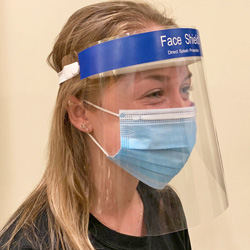From: Ken Kretchman <kwkretch**At_Symbol_Here**ncsu.edu>
Subject: Re: [DCHAS-L] Regulations for Snorkels
Date: February 26, 2019 at 10:11:25 AM GMT-5
Sammye
First...like Harry said....
If you have snorkles (and it is often tough to enclose everything) you would want to test the capture velocity at the point where the contaminant is released and with the snorkle in position. (You might test with smoke as well). That will give you some idea of effectiveness...or lack often lack of as Harry indicates..
You can also test right at the face of the snorkle in the centerline and calculate the cfm.
The appropriate number to look for design cfm is something you should be able to find in the ACGIH Industrial Ventilation Manual.
This is a reference used for design purposes for local exhaust ventilation and a good reference to have on hand.
Your IH group probably has a copy.
thanks
Ken
Ken Kretchman, CIH, CSP Director, Environmental Health and Safety
NC State University / Box 8007 / 2620 Wolf Village Way / Raleigh North Carolina 27695-8007
Email: Ken_Kretchman**At_Symbol_Here**ncsu.edu / Phone: (919).515.6860 / Fax: (919).515.6307
===
From: Monona Rossol <actsnyc**At_Symbol_Here**cs.com>
Subject: Re: [DCHAS-L] Regulations for Snorkels
Date: February 26, 2019 at 10:24:10 AM GMT-5
Sammye, See ACGIH manual: Remember, it's title -- "Industrial Ventilation: A Manual of Recommended Practice." I use the 29th edition, 2016. Don't use much earlier editions if possible. Everything your peeps need is there, but the engineers you need are industrial ventilation designers and this is already their Bible. If instead, your engineers start speaking in ASHRAE, they are not going to be able to do what you need. The ASHRAE standards often reference the ACGIH Manual in footnotes, but it should, in fact, be the first source of standards for lab ventilation rather then a footnote.
For flexible ducts: read Chapter 6 with emphasis on 6.7.4 and see also 13.65 MOVABLE EXHAUST HOODS and VS 65 01. The hood needs to be designed to the purpose (not some generic ASHRAE system). For solvents there is a specific capture velocity within the small capture zone of a flexible duct exhaust which you can find in Chapter 6. If you want to modify an existing system, remember, most were designed for welding so you'll need to check resistance of all components to solvents or whatever else you intend to suck. And avoid those cockamamie off-the-shelf systems with all the knuckle joints which require air to make rapid changes in direction. Those will work as soon as someone repeals the laws of physics.
The welding hood air-flow standard is 1500 f/m measured at the center of the hood's face. But you need to look at your purpose which is not to move a heated particulate but a hot vapor that is in molecular form. Your system can use a lower face velocity based on the size of the hood and the area it needs to function in.
Monona
===
From: "Ellen M. Sweet" <ems325**At_Symbol_Here**cornell.edu>
Subject: RE: [DCHAS-L] Regulations for Snorkels
Date: February 26, 2019 at 10:00:25 AM GMT-5
No, other than what Ralph and harry have said about the Industrial Ventilation Manual.
I have had some luck with manufacturer recommendations for specific equipment that is not a fume hood.
Ellen
===
From: "Aaron's Phone" <cycling1**At_Symbol_Here**verizon.net>
Subject: Re: [DCHAS-L] Regulations for Snorkels
Date: February 26, 2019 at 10:09:39 AM GMT-5
Hi all, I would also take a look at ANSI Z9.5. It has good guidance that aligns well with ASHRAE.
Regards,
Aaron Chen, MPH, CIH, FAIHA
---
For more information about the DCHAS-L e-mail list, contact the Divisional membership chair at membership**At_Symbol_Here**dchas..org
Follow us on Twitter **At_Symbol_Here**acsdchas
